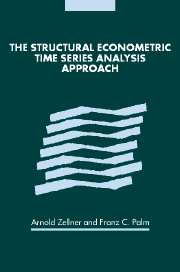Book contents
- Frontmatter
- Contents
- List of contributors
- Acknowledgments
- Introduction
- Part I The SEMTSA approach
- Part II Selected applications
- 6 Time series and structural analysis of monetary models of the US economy (1975)
- 7 Time series versus structural models: a case study of Canadian manufacturing inventory behavior (1975)
- 8 Time series analysis of the German hyperinflation (1978)
- 9 A time series analysis of seasonality in econometric models (1978)
- 10 The behavior of speculative prices and the consistency of economic models (1985)
- 11 A comparison of the stochastic processes of structural and time series exchange rate models (1987)
- 12 Encompassing univariate models in multivariate time series: a case study (1994)
- Part III Macroeconomic forecasting and modeling
- Part IV Disaggregation, forecasting, and modeling
- Subject index
- Author index
- References
7 - Time series versus structural models: a case study of Canadian manufacturing inventory behavior (1975)
Published online by Cambridge University Press: 24 October 2009
- Frontmatter
- Contents
- List of contributors
- Acknowledgments
- Introduction
- Part I The SEMTSA approach
- Part II Selected applications
- 6 Time series and structural analysis of monetary models of the US economy (1975)
- 7 Time series versus structural models: a case study of Canadian manufacturing inventory behavior (1975)
- 8 Time series analysis of the German hyperinflation (1978)
- 9 A time series analysis of seasonality in econometric models (1978)
- 10 The behavior of speculative prices and the consistency of economic models (1985)
- 11 A comparison of the stochastic processes of structural and time series exchange rate models (1987)
- 12 Encompassing univariate models in multivariate time series: a case study (1994)
- Part III Macroeconomic forecasting and modeling
- Part IV Disaggregation, forecasting, and modeling
- Subject index
- Author index
- References
- Type
- Chapter
- Information
- The Structural Econometric Time Series Analysis Approach , pp. 288 - 314Publisher: Cambridge University PressPrint publication year: 2004



